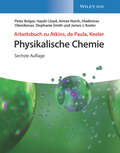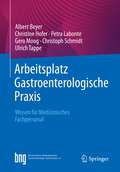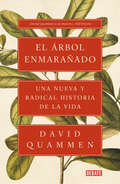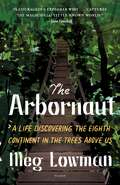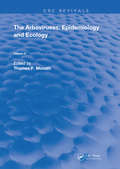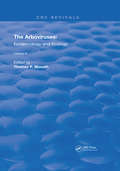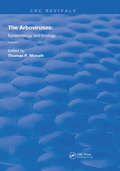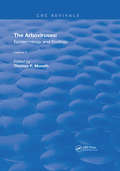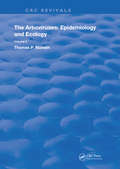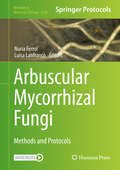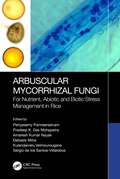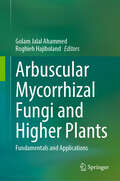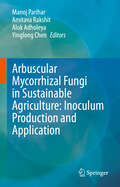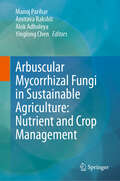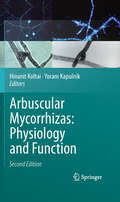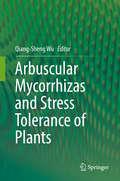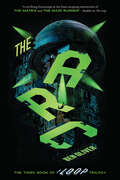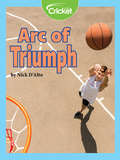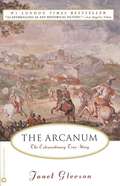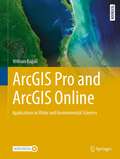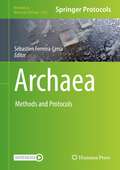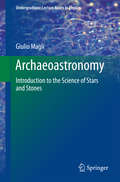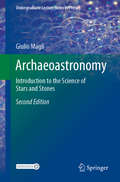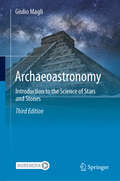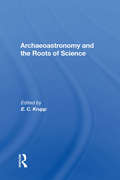- Table View
- List View
Arbeitsbuch zu Atkins, de Paula, Keeler Physikalische Chemie
by Peter Bolgar Haydn Lloyd Aimee North Vladimiras Oleinikovas Stephanie Smith James J. KeelerDas Arbeitsbuch zum neuen "großen Atkins"! Der "große Atkins" ist und bleibt ein Muss für alle Studierenden, die sich ernsthaft mit der Physikalischen Chemie auseinandersetzen. In unverwechselbarem Stil deckt Peter Atkins mit seinen Koautoren Julio de Paula und James Keeler die gesamte Bandbreite dieses faszinierenden und herausfordernden Fachs ab. Das darauf abgestimmte Arbeitsbuch bietet die vollständigen Lösungen der leichteren "a"-Aufgaben und der schwereren Aufgaben sowie Musterantworten zu den ungeraden Diskussionsfragen.
Arbeitsplatz Gastroenterologische Praxis: Wissen für Medizinisches Fachpersonal
by Albert Beyer Christine Hofer Petra Labonte Gero Moog Christoph Schmidt Ulrich TappePraxisbuch für Medizinisches Fachpersonal in einer gastroenterologischen Schwerpunktpraxis Da der Bereich Gastroenterologie in der Ausbildung nur gestreift wird, müssen Medizinische Fachangestellte und Gesundheits- und Krankenpflegerinnen, die in einer gastroenterologischen Praxis oder Klinik arbeiten möchten, ihr Wissen durch "learning by doing" und mit Hilfe von Weiterbildungen erwerben. In diesem Buch profitieren Praxismitarbeiterinnen vom Erfahrungsschatz des renommierten Autorenteams und gewinnen schnell die gewünschte Sicherheit am "Arbeitsplatz in der gastroenterologischen Praxis“. Ob Darmkrebsvorsorge, Endoskopie oder Abrechnung – die Autoren vermitteln das Wissen, das Medizinisches Fachpersonal für die Arbeit in der gastroenterologischen Praxis oder Klinik benötigen. Verständlich fasst es die wichtigsten Krankheitsbilder aus dem Fachbereich zusammen und erläutert medizinische Zusammenhänge. Es werden alltägliche Untersuchungsmethoden von der Endoskopie über den Ultraschall bis hin zum Atemtest erklärt. Ein weiteres Kapitel widmet sich den gastroenterologischen Notfällen. Aber auch viele Praxistipps für die Aufbereitung von Medizinprodukten, zur Hygiene sowie zur Abrechnung erhalten die PraxismitarbeiterInnen in diesem Buch.Ein praxisnahes, kompaktes Buch – verständlich für Medizinisches Fachpersonal geschrieben.
El árbol enmarañado: Una nueva y radical historia de la vida
by David QuammenUn revelador libro que abre las puertas a descubrimientos que podrían transformar radicalmente nuestra manera de concebir la evolución. ¿Quiénes somos, qué somos y cómo evolucionó la vida en nuestro planeta? En la década de los setenta diversos científicos empezaron a comparar secuencias de ADN con el fin de ahondar en nuestro conocimiento sobre la historia de la vida. Su trabajo supuso una drástica revisión de uno de los conceptos más básicos de la biología, la idea del árbol de la vida. Al descubrir que los genes también pueden desplazarse lateralmente, traspasando así los límites entre especies, dieron un vuelco a la certeza tradicional de que los genes se transferían de arriba abajo, es decir únicamente de padres a hijos. Una revelación que no solo ponía en duda cuanto sabíamos sobre la evolución humana, sino que inauguraba una serie nueva de incertidumbres, pues acarreaba importantes implicaciones sobre la identidad, la individualidad y la salud humana. En El árbol enmarañado, David Quammen, uno de los mejores divulgadores científicos de la actualidad, nos presenta este y otros hallazgos trascendentales en el campo de la biología molecular para abrirnos las puertas a descubrimientos que transformarán radicalmente nuestra idea de la evolución. Porque, como dice el autor «no somos precisamente lo que pensábamos que éramos. El árbol de la vida está más enmarañado.» Reseñas:«Quammen no es un escritor corriente. Es sorprendente, uno de esos raros narradores bendecidos con brío, ingenuidad, humor, instinto y con un gran corazón.»Elle «Quammen es el mejor reportero del mundo natural. Cada página desborda descripciones de una autenticidad extraordinaria.»Parul Sehgal, The New York Times «David Quammen demuestra ser un guía excepcional, inmensamente bien informado para una historia de tal complejidad. En mi opinión, es el mejor escritor de historia natural; sus libros impresionan por su precisión, su energía y su escritura brillante y evocativa.»David Barash, The Wall Streer Journal «Quammen has escrito una profunda y atrevida aventura intelectual. El árbol enmarañado es mucho más que un reportaje sobre algunos hechos científicos atractivos; es una auténtica fuente de maravillas.»Thomas Levenson, The Boston Globe «Quammen es un maestro en deconstruir conceptos científicos para luego armar con ellos una narrativa coherente, comprensible y reveladora. Es justamente lo que hace en El árbol enmarañado, centrándose en los científicos que, recientemente, han cambiado todo cuanto sabíamos sobre la evolución, la herencia genética y, sí, el origen de las especies.»Jennifer Bort Yacovissi, Washington Independent Review of Books «La ciencia y la filosofía se interconectan de maneras que a la mayoría de nosotros se nos escapan. Pero Quammen siempre está alerta.»John Archibald, Nature «Un vívido testimonio de cómo la nueva investigación genética está cambiando radicalmente la historia de la vida.»Andrea Thompson, Scientific American «Con humor, lucidez y testimonies increíbles de descubrimientos y contiendas, Quammen repasa minuciosamente las revelaciones que han dejado al descubierto la espectacular complejidad de la vida.»Booklist «Una obra maestro de un nuevo campo de la biología molecular [...] un relato impresionante sobre quizás la revolución científica más desconocida del siglo XX.»Kirkus «Quammen es uno de los mejores periodistas científicos y este libro es una obra colosal, una narración maestra sobre cómo el árbol de la vida fue replanteado por un grupo de pensadores originales.»Barbara Kiser, Nature «Quammen explora temas importantesy
The Arbornaut: A Life Discovering the Eighth Continent in the Trees Above Us
by Meg Lowman“An eye-opening and enchanting book by one of our major scientist-explorers.” —Diane Ackerman, author of The Zookeeper’s WifeNicknamed the “Real-Life Lorax” by National Geographic, the biologist, botanist, and conservationist Meg Lowman—aka “CanopyMeg”—takes us on an adventure into the “eighth continent” of the world's treetops, along her journey as a tree scientist, and into climate actionWelcome to the eighth continent!As a graduate student exploring the rain forests of Australia, Meg Lowman realized that she couldn’t monitor her beloved leaves using any of the usual methods. So she put together a climbing kit: she sewed a harness from an old seat belt, gathered hundreds of feet of rope, and found a tool belt for her pencils and rulers. Up she went, into the trees. Forty years later, Lowman remains one of the world’s foremost arbornauts, known as the “real-life Lorax.” She planned one of the first treetop walkways and helps create more of these bridges through the eighth continent all over the world. With a voice as infectious in its enthusiasm as it is practical in its optimism, The Arbornaut chronicles Lowman’s irresistible story. From climbing solo hundreds of feet into the air in Australia’s rainforests to measuring tree growth in the northeastern United States, from searching the redwoods of the Pacific coast for new life to studying leaf eaters in Scotland’s Highlands, from conducting a BioBlitz in Malaysia to conservation planning in India and collaborating with priests to save Ethiopia’s last forests, Lowman launches us into the life and work of a field scientist, ecologist, and conservationist. She offers hope, specific plans, and recommendations for action; despite devastation across the world, through trees, we can still make an immediate and lasting impact against climate change. A blend of memoir and fieldwork account, The Arbornaut gives us the chance to live among scientists and travel the world—even in a hot-air balloon! It is the engrossing, uplifting story of a nerdy tree climber—the only girl at the science fair—who becomes a giant inspiration, a groundbreaking, ground-defying field biologist, and a hero for trees everywhere.Includes black-and-white illustrations
Arboviruses: Epidemiology and Ecology (Routledge Revivals #3)
by Thomas P. MonathFirst Published in 1988, this five volume set documents the transmission and growth of Arthropod born viruses. Carefully compiled and filled with a vast repertoire of notes, diagrams, and references this book serves as a useful reference for Students of Epidemiology, and other practitioners in their respective fields.
The Arboviruses: Epidemiology and Ecology (Routledge Revivals #4)
by Thomas P. MonathFirst Published in 1988, this five volume set documents the transmission and growth of Arthropod born viruses. Carefully compiled and filled with a vast repertoire of notes, diagrams, and references this book serves as a useful reference for Students of Epidemiology, and other practitioners in their respective fields.
The Arboviruses: Epidemiology and Ecology (Routledge Revivals #1)
by Thomas P. MonathFirst Published in 1988, this five volume set documents the transmission and growth of Arthropod born viruses. Carefully compiled and filled with a vast repertoire of notes, diagrams, and references this book serves as a useful reference for Students of Epidemiology, and other practitioners in their respective fields.
The Arboviruses: Epidemiology and Ecology (Routledge Revivals #5)
by Thomas P. MonathFirst Published in 1988, this five volume set documents the transmission and growth of Arthropod born viruses. Carefully compiled and filled with a vast repertoire of notes, diagrams, and references this book serves as a useful reference for Students of Epidemiology, and other practitioners in their respective fields.
The Arboviruses: Epidemiology and Ecology (Routledge Revivals #2)
by Thomas P. MonathFirst Published in 1988, this five volume set documents the transmission and growth of Arthropod born viruses. Carefully compiled and filled with a vast repertoire of notes, diagrams, and references this book serves as a useful reference for Students of Epidemiology, and other practitioners in their respective fields.
Arbuscular Mycorrhizal Fungi: Methods and Protocols (Methods in Molecular Biology #2146)
by Nuria Ferrol Luisa LanfrancoThis book compiles the most comprehensive collection of protocols currently used in arbuscular mycorrhizal (AM) fungal research. This experience-based collection includes methods for isolation, cultivation, detection, and quantification of AM fungi, as well as the use of metagenomics for community studies and experimental procedures for functional genomics. Written for the highly successful Methods in Molecular Biology series, chapters include introductions to their respective topics, lists of the necessary materials and reagents, step-by-step, readily reproducible laboratory protocols, and tips on troubleshooting and avoiding known pitfalls. Authoritative and cutting-edge, Arbuscular Mycorrhizal Fungi: Methods and Protocols serves as an ideal aid for researchers seeking to perform experiments that fill the gaps in our knowledge of the basic biology, functions, and ecology of AM fungi in the hope of deploying these powerful plant fungal symbionts in agriculture more effectively.
Arbuscular Mycorrhizal Fungi: For Nutrient, Abiotic and Biotic Stress Management in Rice
by Periyasamy PanneerselvamArbuscular mycorrhizal fungi (AMF) are considered enormously important in contemporary agriculture and horticulture due to their important role in nutrient, biotic and abiotic stress management apart from enhancing plant health and soil fertility. AMF is one of the important fungi for soil aggregation, which helps in drought management. Hence this book brings out an exclusive text on AMF for sustainable rice production. It provides comprehensive up-to-date knowledge on AMF in rice cultivation, and for sustainable rice production in different ecologies without damaging the environment. Salient Features: 1. Covers all the aspects of AMF in rice cultivation from diversity to applications 2. Documents AMF diversity based on metagenomic approach in rice ecosystems 3. Explains the importance of AMF in soil aggregation, which helps in drought management 4. Provides new unraveling knowledge about AMF for sustainable rice production in different ecologies without damaging the environment 5. Discusses the AMF role in induction of resistance in rice plants against some pests.
Arbuscular Mycorrhizal Fungi and Higher Plants: Fundamentals and Applications
by Golam Jalal Ahammed Roghieh HajibolandThis book covers the fundamentals of arbuscular mycorrhizal fungi (AMF) and higher plant symbiosis with potential implications in crop production. It provides new insights into our understanding of the mechanisms of AMF-mediated plant growth regulation and stress tolerance covering the most recent biochemical, physiological, molecular, environmental, and ecological studies. Focusing on AMF-induced physiological and molecular mechanisms of enhanced tolerance to stress, environmental stress is discussed in several dedicated chapters. The book provides not only updated information with new insights and perspectives but also several new topics, such as a comprehensive discussion on biotic stressors, AMF interaction with other microorganisms, non-host plant species, plant secondary metabolism, signaling events in plant-AMF symbiosis, AMF-mediated nutrient acquisition and subsequent stress tolerance. The book also discusses the potential implications of AMF for sustainable crop production in the context of climate change. The book can be a useful reference book for academics and scientists involved in related research, such as academics in agronomy and plant sciences, scientists involved in beneficial fungi research, chemists, industrialists, and employees involved in the production and marketing of biofertilizers, master and doctoral degree students of agronomy, horticulture, and plant protection, consultants working on the production of crops in marginal environments as well as environmental scientists working for assisted phytoremediation programs. It would also be suitable for agronomy, ecology, and plant science-related courses, such as plant stress physiology, plant growth-promoting microbes, and plant pathology to teach undergraduate, graduate, and postgraduate students at colleges and universities.
Arbuscular Mycorrhizal Fungi in Sustainable Agriculture: Inoculum Production and Application
by Amitava Rakshit Manoj Parihar Alok Adholeya Yinglong ChenThis 2-volume book is an up-to-date overview of current progress in Arbuscular Mycorrhizal Fungal (AMF) technique development, inoculum production and its quality regulations, application in agriculture, horticulture, agroforestry, and other ecosystems, along with nutrient management for sustainable food production. It contains the current advancement in basic and molecular techniques, challenges, opportunities, and determinates of various AMF production methods and major tools and techniques for their field application. Production and development of AMF is rapidly evolving and requires a multidisciplinary approach with up-to-date knowledge to broaden and strengthen the perspective of researchers involved in this domain. The volumes offer new insight and cutting-edge information for novices and experts such as students, academicians, researchers, environmentalists, industrialists, and others interested in mycorrhiza. The first volume covers some basic isolation techniques, enumeration,and molecular studies with recent advances in various in-vitro and in-vivo production technologies, regulatory issues, and application methodologies for field inoculation. It also discusses AMF application in various agroecosystems for sustainable agricultural production and a healthier planet.
Arbuscular Mycorrhizal Fungi in Sustainable Agriculture: Nutrient and Crop Management
by Amitava Rakshit Manoj Parihar Alok Adholeya Yinglong ChenThis 2 volume book is an up-to-date overview of current progress in Arbuscular Mycorrhizal Fungal (AMF) technique development, inoculum production and its quality regulations, application in agriculture, horticulture, agroforestry and other ecosystems along with nutrient management for sustainable food production. It offers new insight and cutting-edge information for novices and experts such as students, academicians, researchers, environmentalists, industrialists, and other individuals interested in the field of mycorrhiza.AMF provides favorable rhizospheric environment to the plant with numerous direct and indirect mechanisms, in exchange of soil nutrients and photosynthetically fixed carbon. Other than the species composition and diversity determination of natural ecosystem, AMF play a vital role in maintaining the soil quality, agricultural sustainability and environmental integrity. The second volume provide comprehensive knowledge on AMF role in nutrient cycling, nutrient exchange and their acquisition under normal and stress condition.
Arbuscular Mycorrhizas: Physiology And Function
by Hinanit Koltai Yoram KapulnikIn the years since the first edition of "Arbuscular Mycorrhizas: Physiology and Function" was published, an exceptional proliferation of interest in mycorrhizal biology has developed. This has been associated with advances in different research disciplines such as genetics, genomics, proteomics, metabolomics and physiology, advances which have generated better insight into topics of mycorrhizal biology, including the mechanisms of host-mycorrhiza interactions pre- and post-penetration, the influence of the symbiosis on the host and its surroundings, and the evolution and diversity of mycorrhization. It therefore became necessary to both update and expand the book's coverage in this, its second edition.
Arbuscular Mycorrhizas and Stress Tolerance of Plants
by Qiang-Sheng WuThis book reviews the potential mechanisms in arbuscular mycorrhizas (AMs), in the hope that this can help arbuscular mycorrhizal fungi (AMF) to be more used efficiently as a biostimulant to enhance stress tolerance in the host plants. AMF, as well as plants, are often exposed to all or many of the abiotic and biotic stresses, including extreme temperatures, pH, drought, water-logging, toxic metals and soil pathogens. Studies have indicated a quick response to these stresses involving several mechanisms, such as root morphological modification, reactive oxygen species change, osmotic adjustment, direct absorption of water by extraradical hyphae, up-regulated expression of relevant stressed genes, glomalin-related soil protein release, etc. The underlying complex, multi-dimensional strategy is involved in morphological, physiological, biochemical, and molecular processes. The AMF responses are often associated with homeostatic regulation of the internal and external environment, and are therefore critical for plant health, survival and restoration in native ecosystems and good soil structure.
The Arc (The Loop)
by Ben OliverIn the final installment of critically acclaimed Loop trilogy, all of humanity hinges on the greatest escape yet.All hope has seemingly been executed.Despite the fact that the truth of their oppressive leaders had been revealed to them, the crowd of Alts cheer as life drained from the boy. But one Alt, Chester “Chilly” Beckett, did not celebrate; his eyes have been opened to the truth. The corpse is dragged away, but Chester remains determined to find out what is going on in the Laboratory on the 65th floor.There, he'll find three subjects tortured in an attempt to extract a regeneration formula… and one of the subjects is, impossibly, a face he never thought he'd seen again. A bold escape sets in motion a race against time as Happy’s plans to release planet-eating nano-bots into the world draw nearer. The Loop team must reassemble, survive Happy’s final attempts to rid the world of the rebels, and figure out how to halt the apocalypse before humanity is destroyed.
Arc of Triumph
by Nick D'AltoEver wonder why sports balls always seem to move in an arc when thrown or hit? Explore the physics of parabolic motion through the use of basketballs, tennis balls, and baseballs. Once you've figured out how the kinetic energy of a thrown ball is replaced by potential energy, you can use these facts to help you play sports in real life!
The Arcanum: The Extraordinary True Story
by Janet GleesonAn extraordinary episode in cultural and scientific history comes to life in the fascinating story of a genius, greed, and exquisite beauty revealed by the obsessive pursuit of the secret formula for one of the most precious commodities of eighteenth century European royalty-fine porcelain.
ArcGIS Pro and ArcGIS Online: Applications in Water and Environmental Sciences (Springer Textbooks in Earth Sciences, Geography and Environment)
by William BajjaliThis textbook serves as a practical guide for undergraduate and graduate students in geology, hydrology, ecology, and environmental sciences, teaching them applied GIS techniques. Presented as a step-by-step tutorial across seventeen chapters, the book starts with the fundamentals of GIS and progresses to real-life examples from geology and water resources. The focus is on ESRI's ArcGIS Pro, covering various tools for spatial, geostatistical, network, and 3-D analysis. Additionally, it explores ArcGIS Online and working with web apps like Web Map, StoryMaps, and GEO App.GIS applications, especially in water and environmental problem-solving, are rapidly growing worldwide. The demand for GIS experts utilizing spatial analysis in environmental science remains high. This textbook equips users with the necessary knowledge to become effective mappers and spatial analysts in the fields of environment, geosciences, and water resources, employing the latest state-of-the-art methodology.Each chapter provides exercises and supplementary materials available for download on SpringerLink, along with additional links for further learning opportunities.
Archaea: Methods and Protocols (Methods in Molecular Biology #2522)
by Sébastien Ferreira-CercaThis volume provides an overview of well-established methods optimized for diverse archaeal model organisms and is a source of protocols facilitating access to the molecular and cellular biology characterization of these fascinating organisms. Chapters are divided into five parts detailing available genetic tools, molecular and cellular biology methods, strategies to study the ecophysiology of archaea, and classroom protocol. Each main thematic part is also introduced by future-oriented and authoritative primers. Written in the format of the highly successful Methods in Molecular Biology series, each chapter includes an introduction to the topic, lists necessary materials and reagents, includes tips on troubleshooting and known pitfalls, and step-by-step, readily reproducible protocols. Authoritative and cutting-edge, Archaea: Methods and Protocols aims to be a foundation for future studies and to be a source of inspiration for new investigations in the field.
Archaeoastronomy: Introduction to the Science of Stars and Stones (Undergraduate Lecture Notes in Physics)
by Giulio MagliThis book provides the first complete, easy to read, up-to-date account of the fascinating discipline of archaeoastronomy, in which the relationship between ancient constructions and the sky is studied in order to gain a better understanding of the ideas of the architects of the past and of their religious and symbolic worlds. The book is divided into three sections, the first of which explores the past relations between astronomy and people, power, the afterworld, architecture, and landscape. The fundamentals of archaeoastronomy are then addressed in detail, with coverage of the celestial coordinates; the apparent motion of the Sun, Moon, stars, and planets; observation of celestial bodies at the horizon; the use of astronomical software in archaeoastronomy; and current methods for making and analyzing measurements. The final section reviews what archaeoastronomy can now tell us about the nature and purpose of such sites and structures as Stonehenge, the Pyramids of Giza, Chichen Itza, the Campus Martius, and the Valley of the Temples of Agrigento. In addition, a set of exercises is provided that can be performed using non-commercial free software, e. g. , Google Earth or Stellarium, and will equip readers to conduct their own research. Readers will find the book an ideal introduction to what has become a wide-ranging multidisciplinary science.
Archaeoastronomy: Introduction to the Science of Stars and Stones (Undergraduate Lecture Notes in Physics)
by Giulio MagliThis is a second edition of a textbook that provides the first comprehensive, easy-to-read, and up-to-date account of the fascinating discipline of archaeoastronomy, in which the relationship between ancient constructions and the sky is studied in order to gain a better understanding of the ideas of the architects of the past and of their religious and symbolic worlds. The book is divided into three sections, the first of which explores the past relations between astronomy and people, power, the afterworld, architecture, and landscape. The second part then discusses in detail the fundamentals of archaeoastronomy, including the celestial coordinates; the apparent motion of the sun, moon, stars, and planets; observation of celestial bodies at the horizon; the use of astronomical software in archaeoastronomy; and current methods for making and analyzing measurements. The final section reviews what archaeoastronomy can now tell us about the nature and purpose of such sites and structures as Stonehenge, the Pyramids of Giza, Chichen Itza, the Angkor Temples, the Campus Martius, and the Valley of the Temples of Agrigento. In addition, it provides a set of exercises that can be performed using non-commercial free software, e.g., Google Earth and Stellarium, and that will equip readers to conduct their own research. This new edition features a completely new chapter on archaeoastronomy in Asia and an “augmented reality” framework, which on the one hand enhances the didactic value of the book using direct links to the relevant sections of the author’s MOOC (online) lessons and, on the other, allows readers to directly experience – albeit virtually –many of the spectacular archaeological sites described in the book. This is an ideal introduction to what has become a wide-ranging multidisciplinary science.
Archaeoastronomy: Introduction to the Science of Stars and Stones
by Giulio MagliThis book provides the first comprehensive, easy-to-read, and up-to-date account of the fascinating discipline of archaeoastronomy, in which the relationship between ancient constructions and the sky is studied to gain a better understanding of the ideas of the architects of the past and their religious and symbolic worlds. The book is divided into three sections. The first section discusses in detail the fundamentals of archaeoastronomy, including the celestial coordinates, the apparent motion of the sun, moon, stars, and planets, observation of celestial bodies at the horizon, the use of astronomical software in archaeoastronomy, and current methods for making and analyzing measurements . The second part explores the past relations between astronomy and people, power, the afterworld, architecture, and landscape The final section reviews what archaeoastronomy can now tell us about the nature and purpose of such sites and structures as Stonehenge, the Pyramids of Giza, Chichen Itza, the Angkor Temples, the Campus Martius, Machu Picchu and the Valley of the Temples of Agrigento. Additionally, it provides a set of exercises that can be performed using non-commercial free software, e.g., Google Earth and Stellarium, and that will equip readers to conduct their research. This book is an ideal introduction to what has become a wide-ranging multidisciplinary science. This newly revised edition includes the most recent research on Stonehenge, ancient Japan, and other sites worldwide.
Archaeoastronomy And The Roots Of Science
by E. C. KruppArchaeoastronomy is a rapidly developing interdisciplinary inquiry into the minds of our prehistoric and ancient ancestors, one that attempts to reconstruct the ways in which early peoples made use of the sky and its significance to them. Astronomy appears to be a fundamental component of culture, making the scope of archaeoastronomy worldwide. Thi
